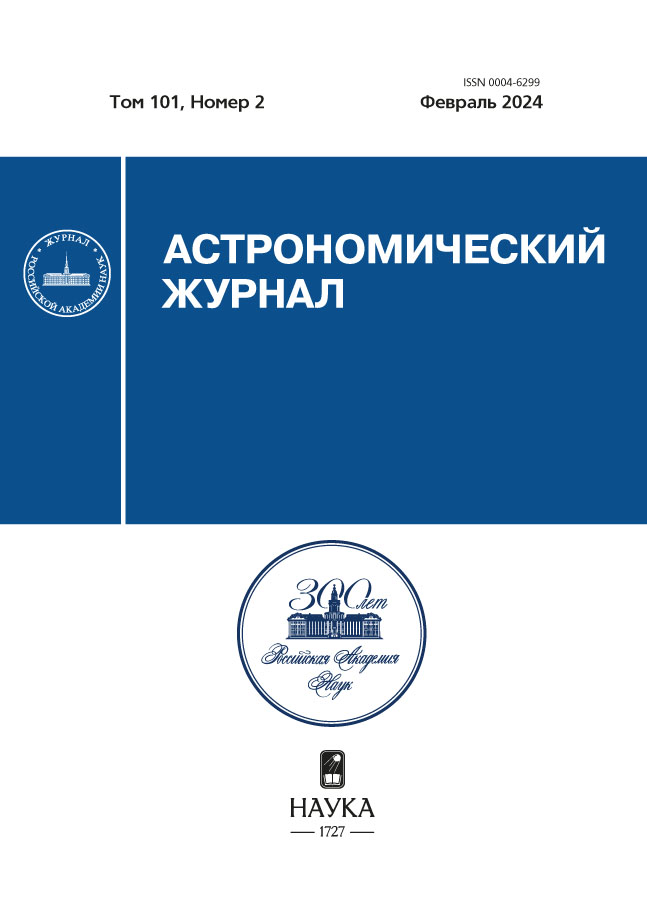Prediction of geomagnetic storms associated with interplanetary coronal mass ejections
- Authors: Rodkin D.G.1, Slemzin V.A.1
-
Affiliations:
- Lebedev Physical Institute, Russian Academy of Sciences
- Issue: Vol 101, No 2 (2024)
- Pages: 165-173
- Section: Articles
- URL: https://cardiosomatics.ru/0004-6299/article/view/647633
- DOI: https://doi.org/10.31857/S0004629924020094
- EDN: https://elibrary.ru/KSYVJD
- ID: 647633
Cite item
Abstract
Geomagnetic storms have a significant impact on the performance of technical systems both in space and on Earth. The sources of strong geomagnetic storms are most often interplanetary coronal mass ejections (ICMEs), generated by coronal mass ejections (CMEs) in the solar corona. The ICME forecast is based on regular optical observations of the Sun, which make it possible to detect CMEs at the formation stage. It is known that the intensity of geomagnetic storms correlates with the magnitude of the southern component of the magnetic field (Bz) of the ICME. However, it is not possible yet to predict the sign and magnitude of Bz from solar observations for the operational forecast of an arbitrary CME. Under these conditions, a preliminary forecast of the magnetic storm probability can be obtained under the assumption that the strength of the storm is related to the magnitude of the magnetic flux from the eruption region, observed as dimming. In this paper we examine the relationship between the integral magnetic flux from the dimming region and the probability that CMEs associated with them will cause geomagnetic storms, using a series of 37 eruptive events in 2010–2012. It is shown that there is a general trend toward an increase in the ICMEs geoefficiency with an increase in the magnitude of the magnetic flux from the dimming region. It has been demonstrated that the frequency of moderate and severe storms observation increases in cases of complex events associated with the interaction of CMEs with other solar wind streams in the heliosphere.
Full Text
About the authors
D. G. Rodkin
Lebedev Physical Institute, Russian Academy of Sciences
Author for correspondence.
Email: rodkindg@gmail.com
Russian Federation, Moscow
V. A. Slemzin
Lebedev Physical Institute, Russian Academy of Sciences
Email: rodkindg@gmail.com
Russian Federation, Moscow
References
- I.G. Richardson, and H.V. Cane, J. Geophys. Res. 109, A09104 (2004).
- I.G. Richardson, and H.V. Cane, Solar Phys. 264, 189–237 (2010).
- Ю.И. Ермолаев, Н.С. Николаева, И.Г. Лодкина, М.Ю. Ермолаев, Космич. исслед. 47, 99–113 (2009).
- Ю.И. Ермолаев, И.Г. Лодкина, Н.С. Николаева, М.Ю. Ермолаев, Космич. исслед. 48, 499 (2010).
- Y.I. Yermolaev, N.S. Nikolaeva, I.G. Lodkina, M.Y. Yermolaev, J. Geophys. Res. 117, A00L07 (2012).
- Y.I. Yermolaev, I.G. Lodkina, N.S. Nikolaeva, M.Y. Yermolaev, J. Geophys. Res.: Space Physics. 118, 4760 (2013).
- T.V. Podladchikova, A.A. Petrukovich, Space Weather 10, S07001 (2012).
- Y. Tan, Q. Hu, Z. Wang, Q. Zhong, Space Weather 16, 406–416 (2018).
- I.S. Zhelavskaya, R. Vasile, Y.Y. Shprits, C. Stolle, J. Matzka, Space weather 17, 1461–1486 (2019).
- J. Wang, B. Luo, S. Liu, L. Shi, Front. Astron. Space Sci. 10 (2023).
- Y. Shugay, V. Kalegaev, K. Kaportseva, V. Slemzin, D. Rodkin, and V. Eremeev, Universe 8, 565 (2022).
- M. Temmer, C. Scolini, I.G. Richardson, S.G. Heinemann, et al., Advances in Space Research. In press (2023).
- D. Odstrcil, Adv. Space Res. 32, 497–506 (2003).
- S. Poedts, A. Lani, C. Scolini, C. Verbeke, et al., J. Space Weather Space Clim. 10, 57 (2020).
- L.F. Burlaga, S.P. Plunkett, O.C. St. Cyr, J. Geophys. Res. 107, 1266 (2002).
- L. Burlaga, D. Berdichevsky, N. Gopalswamy, R. Lepping, T. Zurbuchen, J. Geophys. Res. 108, 1425 (2003).
- N. Lugaz, M. Temmer, Y. Wang, C. J. Farrugia, Solar Phys. 292, 64 (2017).
- D. Rodkin, V. Slemzin, A. N. Zhukov, F. Goryaev, Y. Shugay, I. Veselovsky, Solar Phys. 293, 78 (2018).
- В.А. Слемзин, Ф.Ф. Горяев, Д.Г. Родькин, Ю.С. Шугай, С. В. Кузин, Физика плазмы 45, 867–902 (2019).
- Д.Г. Родькин, В.А. Слемзин, Ю.С. Шугай, Краткие сообщения по физике 47, 36–43 (2020).
- R.A. Harrison, P. Bryans, G.M. Simnett, and M. Lyons, Astron. and Astrophys. 400, 1071–1083 (2003).
- K. Dissauer, A.M. Veronig, M. Temmer, and T. Podladchikova, Astrophys. J. 874, 123 (2019).
- K. Dissauer. A.M. Veronig. M. Temmer. and T. Podladchikova, K. Vanninathan, Astrophys. J. 863. 169 (2018).
- G. Chikunova, K. Dissauer, T. Podladchikova, A.M. Veronig, Astrophys. J. 896. 17 (2020).
- I.M. Chertok, V.V. Grechnev, A.V. Belov, A.A. Abunin, Solar Phys. 282, 175–199 (2013).
- I.M. Chertok, M.A. Abunina, A.A. Abunin, A.V. Belov, V.V. Grechnev, Solar Phys. 290, 627–633 (2015).
- I.M. Chertok, V.V. Grechnev, A.A. Abunin, Solar Phys. 292, 62 (2017).
- S. Pal, D. Nandy, E. Kilpua, Astron. and Astrophys. 665, A110 (2022).
- K. Dissauer. A. M. Veronig. M. Temmer, T. Podladchikova, K. Vanninathan, Astrophys. J. 855, 137 (2018).
- P. J. Cargill, Solar Phys. 221, 135 (2004).
- B. Vršnak, T. Žic, D. Vrbanec, M. Temmer, T. Rollett, C. Möstl, A. Veronig, J. Calogovic, M. Dumbovic, S. Lulic, Y.-J. Moon, and A. Shanmugaraju, Solar Phys. 285, 295 (2013).
- A. Vourlidas, S. Patsourakos, and N. P. Savani, Philosophical Transactions of the Royal Society A: Mathematical, Physical and Engineering Sciences. 377, 20180096 (2019).
- M. Dumbovic, J. Calogovic, K. Martinic, B. Vrsnak, D. Sudar, M. Temmer, and A. Veronig, Frontiers in Astronomy and Space Sciences. 8, 58 (2021).
- T. Zurbuchen, I.G. Richardson, Space Sci. Rev. 123, 31–43 (2006).
- J. Čalogović, M. Dumbović, D. Sudar, B. Vršnak, K. Martinić, M. Temmer, and A. Veronig, Solar Phys. 296, 114 (2021).
- Д.Г. Родькин, В.А. Слемзин, Ю.С. Шугай, Астрон. журн. 100, 1–8 (2023).
- P. Riley, M.L. Mays, J. Andries, T. Amerstorfer, et al., Space Weather 16, 1245–1260 (2018).
- N. Lugaz, C.J. Farrugia, R.M. Winslow, N. Al-Haddad, E.K. J Kilpua, P. Riley, J. Geophys. Res.: Space Physics 121, 10861–10879 (2016).
Supplementary files












